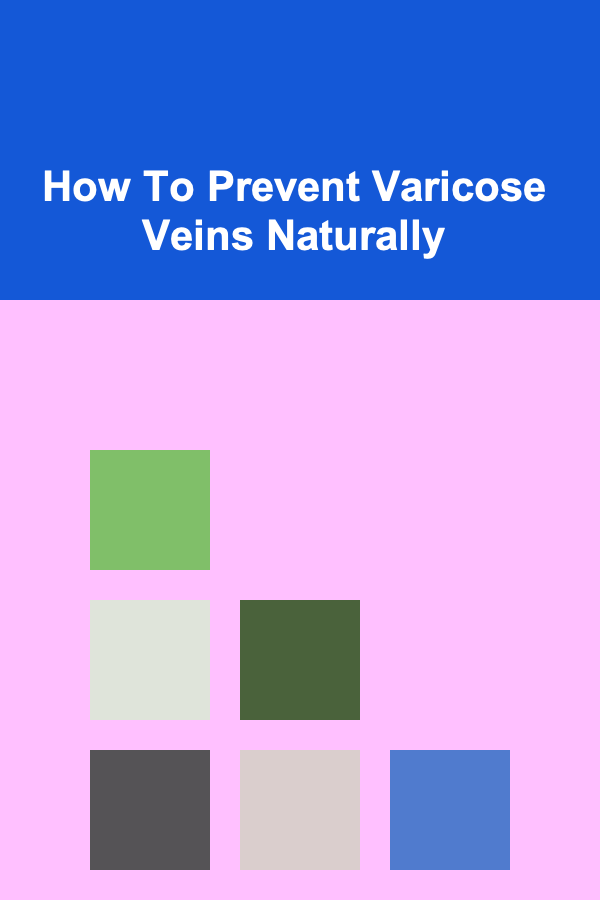
How To Prevent Varicose Veins Naturally
ebook include PDF & Audio bundle (Micro Guide)
$12.99$6.99
Limited Time Offer! Order within the next:

Varicose veins are a common condition that affects millions of people worldwide, primarily impacting the veins in the legs and feet. These veins become enlarged, swollen, and twisted, leading to visible blue or purple bulges on the skin's surface. While varicose veins are often considered a cosmetic issue, they can also cause pain, discomfort, and in some cases, serious health problems such as blood clots or ulcers.
The condition arises when the valves in veins, which help regulate blood flow, weaken or malfunction. This causes blood to pool in the veins, resulting in the telltale bulging and swelling. While some factors, such as age, genetics, and hormonal changes, are beyond our control, several natural strategies can be employed to prevent and manage varicose veins. By focusing on lifestyle modifications, dietary choices, and specific exercises, it's possible to reduce the risk of developing varicose veins or to alleviate their symptoms naturally.
In this article, we will explore various natural methods to prevent varicose veins, from exercise to dietary adjustments, as well as practical tips for maintaining good vein health.
Understanding Varicose Veins
Before we delve into prevention methods, it's essential to understand the underlying causes of varicose veins. The veins in your body contain one-way valves that help blood flow toward the heart. When these valves weaken or become damaged, blood can flow backward and pool in the veins, causing them to enlarge and twist. This condition is most common in the legs because the veins in this area must work against gravity to return blood to the heart.
Several factors can contribute to the development of varicose veins, including:
- Age: As you get older, the veins may lose their elasticity, and the valve system may not function as efficiently.
- Gender: Women are more likely to develop varicose veins due to hormonal changes during pregnancy, menstruation, or menopause.
- Genetics: A family history of varicose veins increases the likelihood of developing the condition.
- Obesity: Excess weight puts additional pressure on the veins, increasing the risk of varicose veins.
- Prolonged Standing or Sitting: Occupations or activities that require long periods of standing or sitting can hinder blood circulation and contribute to vein issues.
While varicose veins can be unsightly and uncomfortable, they are generally not life-threatening. However, if left untreated, they can lead to complications such as blood clots, skin ulcers, and chronic venous insufficiency. Fortunately, with a proactive approach, you can reduce your risk of developing varicose veins and manage existing symptoms naturally.
Maintaining a Healthy Weight
One of the most effective ways to prevent varicose veins naturally is by maintaining a healthy weight. Excess body weight places significant pressure on the veins in the legs, particularly the lower legs. This added pressure can cause the veins to weaken over time, making it more difficult for the blood to flow effectively back to the heart.
Carrying excess weight also increases the strain on the cardiovascular system, further contributing to the development of varicose veins. By adopting a balanced diet and engaging in regular physical activity, you can maintain a healthy weight and reduce the risk of varicose veins.
How to Achieve a Healthy Weight:
- Eat a balanced diet: Focus on a diet rich in fruits, vegetables, whole grains, lean proteins, and healthy fats. This will provide essential nutrients that support vein health, including vitamin C, vitamin E, and flavonoids.
- Limit processed foods and sugar: Processed foods, sugary snacks, and refined carbohydrates can contribute to weight gain and inflammation, both of which can exacerbate varicose veins.
- Exercise regularly: Regular exercise, such as walking, swimming, or cycling, helps to burn calories, improve circulation, and strengthen the muscles in the legs, which in turn supports vein health.
Regular Exercise and Physical Activity
Exercise plays a crucial role in the prevention and management of varicose veins. Physical activity helps to improve blood circulation, which is essential for maintaining healthy veins. When you exercise, your muscles contract, helping to push blood through the veins back toward the heart. This action prevents blood from pooling in the veins and reduces the risk of varicose veins.
Some of the best exercises for preventing varicose veins include:
Walking
Walking is one of the simplest and most effective exercises for improving circulation. It engages the muscles in the legs, which helps to pump blood through the veins. Aim for at least 30 minutes of brisk walking each day to enhance circulation and reduce the risk of varicose veins.
Cycling
Cycling, whether outdoors or on a stationary bike, is another excellent cardiovascular exercise that helps improve blood flow in the legs. Cycling also strengthens the calf muscles, which are essential for promoting circulation and preventing blood from pooling in the veins.
Swimming
Swimming is a low-impact exercise that provides an excellent full-body workout while promoting healthy circulation. The buoyancy of the water reduces the pressure on the legs, making it a great option for individuals who have joint pain or are at a higher risk of developing varicose veins.
Leg Elevation Exercises
In addition to regular physical activity, elevating the legs can help prevent and alleviate varicose veins. When you elevate your legs above the level of your heart, gravity helps blood flow more efficiently back to the heart, reducing pressure in the veins. Consider incorporating leg elevation into your daily routine by lying down and propping your legs up on a cushion for 15-20 minutes a few times a day.
Improve Circulation with Compression Stockings
Compression stockings are specially designed to provide gentle pressure on the legs, which helps improve blood flow and reduce the risk of varicose veins. These stockings work by compressing the veins and helping the blood to circulate more effectively. Compression stockings can be particularly useful for individuals who have jobs that require prolonged standing or sitting, as well as for those who are already experiencing mild varicose veins.
Compression stockings come in various strengths and lengths, from knee-high to thigh-high, and can be purchased over-the-counter or prescribed by a healthcare professional. It's important to choose the right compression level based on your needs and comfort level. Consult with a healthcare provider if you're unsure which type of compression stocking is best for you.
Eat a Vein-Healthy Diet
Diet plays an important role in preventing varicose veins, as certain nutrients support the health of your veins and blood vessels. A well-balanced diet can help reduce inflammation, improve circulation, and strengthen the walls of your veins, reducing the likelihood of varicose veins.
Key Nutrients for Vein Health:
- Flavonoids: Found in fruits, vegetables, and citrus fruits, flavonoids have antioxidant properties that help improve circulation and reduce inflammation in the veins. Common sources of flavonoids include berries, apples, grapes, and citrus fruits.
- Vitamin C: This vitamin is essential for collagen production, which helps strengthen the walls of blood vessels. Vitamin C is found in high amounts in citrus fruits, berries, peppers, and leafy green vegetables.
- Vitamin E: Vitamin E helps improve blood circulation and protects the veins from oxidative stress. Sources of vitamin E include nuts, seeds, spinach, and broccoli.
- Fiber: A high-fiber diet helps prevent constipation, which can contribute to the development of varicose veins by causing increased pressure in the abdominal and pelvic regions. Foods high in fiber include whole grains, fruits, vegetables, and legumes.
In addition to these nutrients, it's essential to stay hydrated by drinking plenty of water throughout the day. Proper hydration supports healthy blood circulation and helps prevent the formation of blood clots.
Avoid Prolonged Standing or Sitting
Prolonged periods of standing or sitting can contribute to poor circulation and increase the risk of varicose veins. When you remain in one position for too long, blood tends to pool in the lower legs, placing additional strain on the veins. This is particularly common in occupations that require long hours of standing or sitting, such as teaching, retail work, or office jobs.
To reduce the risk of varicose veins, take frequent breaks to move around and change positions. If you're sitting for long periods, make a habit of standing up and walking around every 30-60 minutes. If you're standing for extended periods, shift your weight between legs, or use a footstool to elevate one leg at a time.
Use Herbal Remedies and Natural Supplements
Several herbal remedies and natural supplements have been suggested to improve circulation and support vein health. While more research is needed in some areas, the following herbs and supplements have shown promise in promoting healthy veins:
- Horse Chestnut: This herb has been traditionally used to treat varicose veins due to its ability to strengthen vein walls and improve circulation. Horse chestnut extract is available in supplement form, and topical creams are also available.
- Butcher's Broom: Known for its anti-inflammatory properties, butcher's broom can help reduce swelling and improve blood circulation. It is often used in combination with other vein-supporting herbs.
- Ginkgo Biloba: Ginkgo biloba is an herb known to improve circulation and blood flow. It may help reduce symptoms of varicose veins, such as swelling and discomfort.
- Vitamin K: Vitamin K is essential for blood clotting and healthy veins. Some studies suggest that it may help improve circulation and reduce the appearance of varicose veins.
Before using any herbal remedies or supplements, consult with a healthcare professional to ensure they are safe and appropriate for your specific health needs.
Conclusion
Varicose veins can be a troublesome and unsightly condition, but with a proactive approach, it is possible to prevent and manage them naturally. By maintaining a healthy weight, staying active, improving circulation through exercises and compression stockings, and eating a nutrient-rich diet, you can significantly reduce the risk of developing varicose veins.
Additionally, avoiding prolonged periods of standing or sitting and using herbal remedies may further support healthy vein function. Although these strategies cannot guarantee that varicose veins will not develop, they can go a long way in supporting your overall vascular health and minimizing the risk of complications.
If you notice signs of varicose veins or experience symptoms such as pain, swelling, or heaviness in your legs, consult with a healthcare professional for personalized advice and treatment options. With the right preventive measures, you can keep your veins healthy and reduce the impact of varicose veins on your daily life.

How to Balance Short-Term and Long-Term Goals Effectively
Read More
How to Handle Cancellations and Refund Requests in Event Registration
Read More
How to Host a Family Cooking Night with Simple Recipes
Read More
How To Understand Global Shipping for Print-on-Demand
Read More
How To Foster a Sense of Wonder and Awe
Read More
How To Exercise Your Right to Lodge a Complaint
Read MoreOther Products

How to Balance Short-Term and Long-Term Goals Effectively
Read More
How to Handle Cancellations and Refund Requests in Event Registration
Read More
How to Host a Family Cooking Night with Simple Recipes
Read More
How To Understand Global Shipping for Print-on-Demand
Read More
How To Foster a Sense of Wonder and Awe
Read More